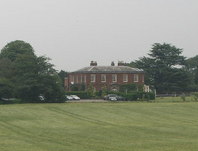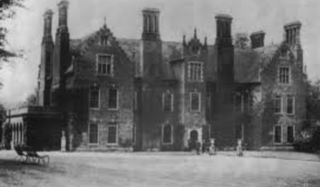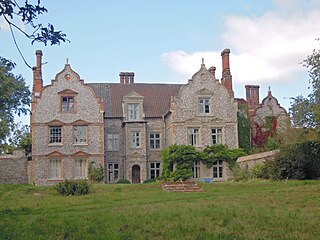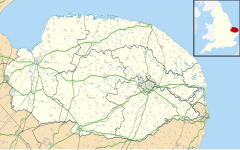Baron Suffield, of Suffield in the County of Norfolk, is a hereditary title in the Peerage of Great Britain.

Sir Thomas Fowell Buxton, 1st Baronet Buxton of Belfield and Runton was an English Member of Parliament, brewer, abolitionist and social reformer. He married Hannah Gurney, whose sister became Elizabeth Fry, and became a great friend of her father Joseph Gurney and the extended Gurney family.

Charles Harbord, 5th Baron Suffield, was a British peer, courtier and Liberal politician. A close friend of Edward VII, he served as a Lord of the Bedchamber and Lord-in-waiting to the King. He also held political office as Master of the Buckhounds under William Gladstone between February and July 1886.

John Hobart, 1st Earl of Buckinghamshire, was a British politician who sat in the House of Commons from 1715 to 1728, when he was raised to the peerage as Baron Hobart.
The high sheriff is the oldest secular office under the Crown and is appointed annually by the Crown. The High Sheriff of Norfolk was originally the principal law enforcement officer in Norfolk and presided at the assizes and other important county meetings. Most of the responsibilities associated with the post have been transferred elsewhere or are now defunct, so that its functions are now largely ceremonial. There was a single high sheriff serving the two counties of Norfolk and Suffolk until 1576.

Horstead Hall was a country house in Norfolk that was demolished in the 1950s.

Lieutenant-Colonel Guy Greville Wilson, was a British soldier, company director, and Liberal Party politician from Kingston upon Hull. His family owned Thomas Wilson Sons & Co., which was once the largest private shipowning concern in the world.

Edward Harbord, 3rd Baron Suffield, styled The Honourable Edward Harbord between 1786 and 1821, was a British liberal politician, anti-slavery campaigner and prison reformer.

Harbord Harbord, 1st Baron Suffield, known as Sir Harbord Harbord, Bt, between 1770 and 1786, was a British landowner and politician who sat in the House of Commons from 1756 to 1784 when he was raised to the peerage as Baron Suffield.
The Gurneys were an influential family of English Quakers, who had a major part in the development of Norwich, England. They established Gurney's Bank in 1770, which merged into Barclays Bank in 1896. A number of family members were abolitionists. Members of the family still live in the United Kingdom.

Edward Boardman (1833–1910) was a Norwich born architect. He succeeded John Brown as the most successful Norwich architect in the second half of the 19th century. His work included both civic and ecclesiastical buildings, in addition to private commissions. Together, with his rival, George Skipper, he produced many notable buildings with several standing to this day (2013).
Robert Brightiffe or Britiffe, of Baconsthorpe, Norfolk, was an English lawyer and Whig politician. He sat in the House of Commons from 1715 to 1734 and served as recorder of Norwich in 1737–1743.

Hoveton Hall in the parish of Hoveton in Norfolk is a Regency-style country house made of gault brick with a slate roof. It was built between 1809 and 1812, on or near the site of the previous ancient manor house of the same name, by Mrs Christabell Burroughes (1764-1843), daughter and heiress of Henry Negus (1734-1807) of Hoveton Hall, an attorney, and wife of James Burkin Burroughes (1760-1803) of Burlingham Hall, Norfolk. The architect was Humphry Repton. It is a well-preserved historic house of significance on the English Heritage Register. The Negus family had been seated at Hoveton Hall for several generations. The surrounding estate today consists of 120 acres of gardens and parkland and 450 acres of arable land as well as picturesque woodland. The gardens are open to the public during part of the year and there are facilities available for accommodation and special events including weddings.

Dovecliff Hall is a large Georgian country house in Stretton, East Staffordshire, England which is now a country house hotel. It is a Grade II listed building.

Spixworth Hall was an Elizabethan country house in the civil parish of Spixworth in Norfolk, located just north of the city of Norwich on the Buxton Road. It was demolished in 1952.

Longe is a surname of Anglo-Norman origin. The name Longe derives from the Anglo-Norman French ‘Lung’ or ‘Lang’ for tall or high. The family descend from the noble family of de Préaux who were barons in Préaux, Roumois and Darnétal, Normandy. Variants of the name include: le Long, de Long, Le Lung, Longe, Long and Longue. The family are believed to have arrived in England following the Norman Conquest and during the early 13th century divided into two branches, the Wiltshire branch and the Norfolk branch. In the Hundred Rolls of 1273, early variations have been found including, Henry le Longe in Buckinghamshire, John le Longe in Huntingdonshire; and Walter le Longe in Shropshire.

Wiveton Hall is a country house in Wiveton, Norfolk, England. It is Grade II* listed. It was built in 1652 and extended in 1908. However there are remains of an older building in the garden which could date back to 1280. It was the residence of many notable people over the next three centuries and is now the home of the MacCarthy family. The Hall provides holiday cottage accommodation, a restaurant café, a farm and gift shop and has garden tours. The West Wing is available for weddings and other special events.

Sir William Harbord, 1st Baronet, of Gunton and Suffield, Norfolk, was an English landowner and politician who sat in the House of Commons from between 1734 and 1754.

Morston Hall in the parish of Morston near Holt, Norfolk, is a building of historical significance. The original house was built in about 1640 and cellars and chimneys from it survive. It was substantially altered in the 18th century and a wing was added in the 19th century. It was owned by the Townshend viscounts from Raynham Hall from the 17th century until 1911 and during this time it was tenanted by various notable people. Today it is a hotel. It also caters for special events particularly weddings.
The Reverend Arthur Buxton was a clergyman of the Church of England, Rector of All Souls Church, Langham Place, Marylebone, after serving as Chaplain to the Forces during the First World War.



















